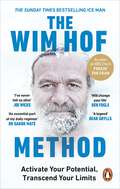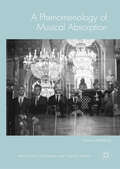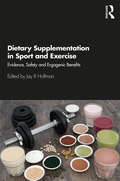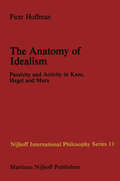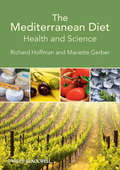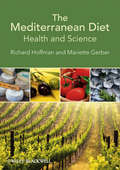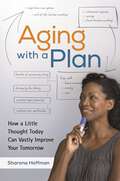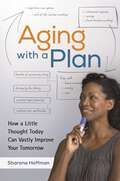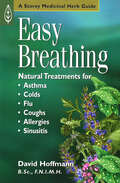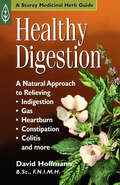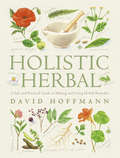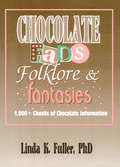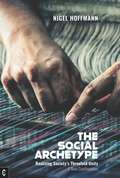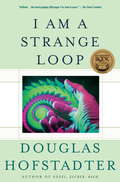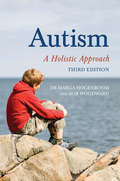- Table View
- List View
The Wim Hof Method: Activate Your Potential, Transcend Your Limits
by Wim HofSTAR OF BBC ONE'S FREEZE THE FEAR 'I've never felt so alive' JOE WICKS'A fascinating look at Wim's incredible life and method' FEARNE COTTON My hope is to inspire you to retake control of your body and life by unleashing the immense power of the mind. 'The Iceman' Wim Hof shares his remarkable life story and powerful method for supercharging your health and happiness. Refined over forty years and championed by scientists across the globe, you'll learn how to harness three key elements of Cold, Breathing and Mindset to take ownership over your own mind and wellbeing.'The book will change your life' BEN FOGLE 'Wim is a legend of the power ice has to heal and empower' BEAR GRYLLS
A Phenomenology of Musical Absorption (New Directions in Philosophy and Cognitive Science)
by Simon HøffdingThis book presents a detailed analysis of what it means to be absorbed in playing music. Based on interviews with one of the world’s leading classical ensembles, “The Danish String Quartet” (DSQ), it debunks the myth that experts cannot reflect while performing, but also shows that intense absorption is not something that can be achieved through will, intention, prediction or planning – it remains something individuals have to be receptive to. Based in the phenomenological tradition of Husserl and Merleau-Ponty as well as of Dan Zahavi and Shaun Gallagher, it lays out the conditions and essential structures of musical absorption. Employing the lived experience of the DSQ members, it also engages and challenges core ideas in phenomenology, philosophy of mind, enactivism, expertise studies, musical psychology, flow theory, aesthetics, dream and sleep studies, psychopathology and social ontology, and proposes a method that integrates phenomenology and cognitive science.
Dietary Supplementation in Sport and Exercise: Evidence, Safety and Ergogenic Benefits
by Jay R HoffmanDietary Supplementation in Sport and Exercise removes the myths associated with many dietary supplements. It provides an evidence-based approach to the physiological mechanisms related to popular supplements and examines the ergogenic benefits in both competitive and recreational athletes. This text covers a variety of supplements, including vitamins and minerals, carbohydrates, protein and amino acids, beta-alanine, creatine and guanidinoacetic acid, caffeine and probiotics, as well as emerging ergogenic aids. Information on dosage, ceiling effects and washout periods is discussed, along with safety and legality for different sporting organizations. The book also offers an insight into the efficacy of certain dietary supplements in unique populations, like children and the elderly. Dietary Supplementation in Sport and Exercise is an important resource for advanced undergraduate and graduate students on exercise science, health and nutrition courses, as well as strength coaches, athletic trainers, nutritionists and personal trainers, and medical professionals who consult with patients on dietary supplementation.
Dietary Supplementation in Sport and Exercise: Evidence, Safety and Ergogenic Benefits
by Jay R HoffmanDietary Supplementation in Sport and Exercise removes the myths associated with many dietary supplements. It provides an evidence-based approach to the physiological mechanisms related to popular supplements and examines the ergogenic benefits in both competitive and recreational athletes. This text covers a variety of supplements, including vitamins and minerals, carbohydrates, protein and amino acids, beta-alanine, creatine and guanidinoacetic acid, caffeine and probiotics, as well as emerging ergogenic aids. Information on dosage, ceiling effects and washout periods is discussed, along with safety and legality for different sporting organizations. The book also offers an insight into the efficacy of certain dietary supplements in unique populations, like children and the elderly. Dietary Supplementation in Sport and Exercise is an important resource for advanced undergraduate and graduate students on exercise science, health and nutrition courses, as well as strength coaches, athletic trainers, nutritionists and personal trainers, and medical professionals who consult with patients on dietary supplementation.
The Anatomy of Idealism: Passivity and Activity in Kant, Hegel and Marx (Nijhoff International Philosophy Series #11)
by P. HoffmanIn its attempt to come to grips with the nature of the human mind idealism employs such terms as "pure self," "transcendental apperception," "pure con sciousness" and so on. What do these terms mean? What do they refer to? Pro visionally, at least, the following answer could be satisfying: such and similar expressions are purported to capture a very special quality of human mind, a quality due to which man is not simply a part of nature, but a being capable of knowing and acting according to principles governing the spiritual realm. In the first chapter of the present study the author attempts to bring the idea of "pure Ego" down to earth. By analyzing Kant's concept of pure appercep tion - the ancestor of all similar notions in the history of modern and contem porary idealism - the author concludes that certain functions and capacities attributed to pure apperception by Kant himself imply the rejection of the idealistic framework and the necessity to "naturalize" the idea of pure self. In other words - and Kant's claims to the contrary notwithstanding - pure ap perception cannot be conceived as superimposed upon man viewed as a part of nature, as a feeling and a sensing being. The referent, as it were, of the expres sion "pure self' turns out to be something much more familiar to us - a human organism, with all its needs, drives and dispositions.
Implementing the Mediterranean Diet: Nutrition in Practice and Public Health
by Richard HoffmanImplementing the Mediterranean Diet Implementing the Mediterranean Diet: Nutrition in Practice and Public Health situates this &‘gold standard&’ of diets within the wider food environment by bridging the gap between the evidence-based health benefits of the Mediterranean diet and its implementation. The text explores the many approaches that can be used by health professionals to help consumers adopt this healthy eating pattern, as well as the barriers encountered with implementing this diet at home and in the wider environment. It also considers sustainable food and farming practices, and national food strategies. A one-stop resource for food and health professionals, this seminal text demonstrates the full range of benefits that the Mediterranean diet can bring to society. This ground-breaking book: Gives an in-depth review of the effectiveness of the Mediterranean diet in disease prevention and the management of chronic diseases Contextualises the diet within the food environment, showing why the whole dietary pattern and minimizing the consumption of highly processed foods are both so important Shows how to implement the Mediterranean diet, motivating and guiding consumers to make the transition Addresses the practical and behavioural barriers to food choice in terms of taste, cost, variety, convenience and animal welfare concerns Implementing the Mediterranean Diet is a must-have resource for advanced undergraduate and postgraduate students in the food sciences, and for healthcare professionals such as dietitians, nutritionists, GPs, and health workers, especially those working in non-Mediterranean, high-income countries.
Implementing the Mediterranean Diet: Nutrition in Practice and Public Health
by Richard HoffmanImplementing the Mediterranean Diet Implementing the Mediterranean Diet: Nutrition in Practice and Public Health situates this &‘gold standard&’ of diets within the wider food environment by bridging the gap between the evidence-based health benefits of the Mediterranean diet and its implementation. The text explores the many approaches that can be used by health professionals to help consumers adopt this healthy eating pattern, as well as the barriers encountered with implementing this diet at home and in the wider environment. It also considers sustainable food and farming practices, and national food strategies. A one-stop resource for food and health professionals, this seminal text demonstrates the full range of benefits that the Mediterranean diet can bring to society. This ground-breaking book: Gives an in-depth review of the effectiveness of the Mediterranean diet in disease prevention and the management of chronic diseases Contextualises the diet within the food environment, showing why the whole dietary pattern and minimizing the consumption of highly processed foods are both so important Shows how to implement the Mediterranean diet, motivating and guiding consumers to make the transition Addresses the practical and behavioural barriers to food choice in terms of taste, cost, variety, convenience and animal welfare concerns Implementing the Mediterranean Diet is a must-have resource for advanced undergraduate and postgraduate students in the food sciences, and for healthcare professionals such as dietitians, nutritionists, GPs, and health workers, especially those working in non-Mediterranean, high-income countries.
The Mediterranean Diet: Health and Science
by Richard Hoffman Mariette GerberRecent large-scale epidemiological studies have confirmed the pre-eminence of the Mediterranean diet for reducing the risk of primary and secondary heart disease and cancer. There is also increasingly convincing evidence for its protective value against diabetes, dementias and other age-related disorders, and for increasing overall longevity. The Mediterranean Diet: Health and Science is a timely, authoritative and accessible account of the Mediterranean diet for nutritionists and dieticians. It discusses the Mediterranean diet in the light of recent developments in nutritional biochemistry, disease mechanisms and epidemiological studies, and also provides advice on nutrition policies and interventions. The Mediterranean Diet: Health and Science opens with an overview of the Mediterranean diet, and this is followed by a survey of the latest epidemiological evidence for its health benefits. There is detailed nutritional information on olive oil, wine, fish, fruit and vegetables and other components of the Mediterranean diet, and this information is used to explain how the diet protects against a range of age-related diseases. The book emphasises the importance of understanding the Mediterranean diet in its totality by discussing the evidence for beneficial interactions between various components of the diet. There are also discussions of how agricultural practices, as well as food preparation and cooking techniques, influence the nutritional quality of the diet. The book concludes by discussing the social context in which the Mediterranean diet is eaten, and public health issues associated with adopting a Mediterranean diet, especially in the context of more northerly countries. Written by nutritional biochemist Richard Hoffman and a past President of the French Nutrition Society, Mariette Gerber, who between them have many years experience in this area, this exciting and highly topical boook is an essential purchase for all nutritionists and dietitians worldwide. Libraries in all universities where nutrition, dietetics and food science and technology are studied and taught should have copies of this excellent book on their shelves.
The Mediterranean Diet: Health and Science
by Richard Hoffman Mariette GerberRecent large-scale epidemiological studies have confirmed the pre-eminence of the Mediterranean diet for reducing the risk of primary and secondary heart disease and cancer. There is also increasingly convincing evidence for its protective value against diabetes, dementias and other age-related disorders, and for increasing overall longevity. The Mediterranean Diet: Health and Science is a timely, authoritative and accessible account of the Mediterranean diet for nutritionists and dieticians. It discusses the Mediterranean diet in the light of recent developments in nutritional biochemistry, disease mechanisms and epidemiological studies, and also provides advice on nutrition policies and interventions. The Mediterranean Diet: Health and Science opens with an overview of the Mediterranean diet, and this is followed by a survey of the latest epidemiological evidence for its health benefits. There is detailed nutritional information on olive oil, wine, fish, fruit and vegetables and other components of the Mediterranean diet, and this information is used to explain how the diet protects against a range of age-related diseases. The book emphasises the importance of understanding the Mediterranean diet in its totality by discussing the evidence for beneficial interactions between various components of the diet. There are also discussions of how agricultural practices, as well as food preparation and cooking techniques, influence the nutritional quality of the diet. The book concludes by discussing the social context in which the Mediterranean diet is eaten, and public health issues associated with adopting a Mediterranean diet, especially in the context of more northerly countries. Written by nutritional biochemist Richard Hoffman and a past President of the French Nutrition Society, Mariette Gerber, who between them have many years experience in this area, this exciting and highly topical boook is an essential purchase for all nutritionists and dietitians worldwide. Libraries in all universities where nutrition, dietetics and food science and technology are studied and taught should have copies of this excellent book on their shelves.
Aging with a Plan: How a Little Thought Today Can Vastly Improve Your Tomorrow
by Sharona HoffmanThis book offers a concise, comprehensive resource for middle-aged readers who are facing the prospects of their own aging and of caring for elderly relatives—an often overwhelming task for which little in life prepares us.Everyone ages, and nearly everyone will also experience having to support aging relatives. Being prepared is the best way to handle this inevitable life stage. This book addresses a breadth of topics that are relevant to aging and caring for the elderly, analyzing each thoroughly and providing up-to-date, practical advice. It can serve as a concise and comprehensive resource read start-to-finish to plan for an individual's own old age or to anticipate the needs of aging relatives, or as a quick-reference guide on specific issues and topics as relevant to each reader's situation and needs.Using an interdisciplinary approach, Aging with a Plan: How a Little Thought Today Can Vastly Improve Your Tomorrow develops recommendations for building sustainable social, legal, medical, and financial support systems that can promote a good quality of life throughout the aging process. Chapters address critical topics such as retirement savings and expenses, residential settings, legal planning, the elderly and driving, long-term care, and end-of-life decisions. The author combines analysis of recent research on the challenges of aging with engaging anecdotes and personal observations. By following the recommendations in this book, readers in their 40s, 50s, and early 60s will greatly benefit from learning about the issues regarding aging in the 21st century—and from investing some effort in planning for their old age and that of their loved ones.
Aging with a Plan: How a Little Thought Today Can Vastly Improve Your Tomorrow
by Sharona HoffmanThis book offers a concise, comprehensive resource for middle-aged readers who are facing the prospects of their own aging and of caring for elderly relatives—an often overwhelming task for which little in life prepares us.Everyone ages, and nearly everyone will also experience having to support aging relatives. Being prepared is the best way to handle this inevitable life stage. This book addresses a breadth of topics that are relevant to aging and caring for the elderly, analyzing each thoroughly and providing up-to-date, practical advice. It can serve as a concise and comprehensive resource read start-to-finish to plan for an individual's own old age or to anticipate the needs of aging relatives, or as a quick-reference guide on specific issues and topics as relevant to each reader's situation and needs.Using an interdisciplinary approach, Aging with a Plan: How a Little Thought Today Can Vastly Improve Your Tomorrow develops recommendations for building sustainable social, legal, medical, and financial support systems that can promote a good quality of life throughout the aging process. Chapters address critical topics such as retirement savings and expenses, residential settings, legal planning, the elderly and driving, long-term care, and end-of-life decisions. The author combines analysis of recent research on the challenges of aging with engaging anecdotes and personal observations. By following the recommendations in this book, readers in their 40s, 50s, and early 60s will greatly benefit from learning about the issues regarding aging in the 21st century—and from investing some effort in planning for their old age and that of their loved ones.
Easy Breathing: Natural Treatments for Asthma, Colds, Flu, Coughs, Allergies, and Sinusitis
by David HoffmannThis accessible handbook details a holistic and natural approach to treating and preventing familiar respiratory conditions, including asthma, allergies, bronchitis, hay fever, sinusitis, and the common cold.
Healthy Bones & Joints: A Natural Approach to Treating Arthritis, Osteoporosis, Tendinitis, Myalgia & Bursitis
by David HoffmannStrengthen your bones and joints naturally! David Hoffman offers expert advice on how herbal treatments can help those suffering from arthritis, rheumatism, osteoporosis, and other musculoskeletal ailments. Detailed profiles of popular medicinal herbs and their healing properties, clear preparation instructions, and dosage guidelines, will help you create custom-tailored remedies suitable to your individual needs. Learn how to incorporate herbs such as meadowsweet, mustard, bay tree, and more into your daily regimen to help prevent and treat aching bones and stiff joints.
Healthy Digestion: A Natural Approach to Relieving Indigestion, Gas, Heartburn, Constipation, Colitis, and More
by David HoffmannThis accessible reference details a holistic and natural approach to treating and preventing common gastrointestinal ailments, including gas, heartburn, constipation, gallstones, and more.
Healthy Heart: Strengthen Your Cardiovascular System Naturally
by David HoffmannThis easy-to-use handbook details safe and effective herbal preparations to treat common cardiovascular conditions, including high blood pressure, congestive heart failure, varicose veins, and angina.
Holistic Herbal: A Safe And Practical Guide To Making And Using Herbal Remedies (Health Workbooks Ser.)
by David HoffmannThe ebook edition of this classic herbal by internationally renowned herbalist David Hoffman. Easy to use, the herbal is hugely popular with herbalists and laypeople worldwide
Chocolate Fads, Folklore & Fantasies: 1,000+ Chunks of Chocolate Information
by Frank Hoffmann Linda K Fuller Beulah B RamirezChocolate Fads, Folklore & Fantasies is the low-cal answer to satisfying chocolate cravings. Documenting the chocolate phenomenon by means of 1,000+ chocolate chunks of information, this tempting book discusses: Chocolate Fads: chocolate books, chocolate goodies (cakes, candy, cookies, ice cream), chocolate clubs, chocolate festivals, chocolate fund-raising, chocolate marketing, chocolate media, and chocolate novelties Chocolate Folklore: chocolate companies, chocolate history, chocolate nutrition, chocolate moguls, chocolate quotes, chocolate tips, chocolate trivia, and chocolate types Chocolate Fantasies: chocoholism, chocolate feasts, chocolate love, chocolate parties, chocolate promotions, and chocolate psychology. At the end of the book is a 200-item Chocoquiz, in the style of Trivial Pursuit, so that readers can use the book as a reference source to know everything there is to know about chocolate.Reference sections include acknowledgments to chocolate manufacturers, chocolate-related companies, a listing of chocolate publications (media articles, children's books, chocolate guides, cookbooks, chocolate humor, and chocolate specialities), and an impressive list of addresses and telephone numbers for more than 100 chocolate and chocolate-related companies. All chocoholics, out of the closet or not, will want to read this book. Chocolate Fads, Folklore & Fantasies promises to be the last word in chocolate, no fudging!
Chocolate Fads, Folklore & Fantasies: 1,000+ Chunks of Chocolate Information
by Frank Hoffmann Linda K Fuller Beulah B RamirezChocolate Fads, Folklore & Fantasies is the low-cal answer to satisfying chocolate cravings. Documenting the chocolate phenomenon by means of 1,000+ chocolate chunks of information, this tempting book discusses: Chocolate Fads: chocolate books, chocolate goodies (cakes, candy, cookies, ice cream), chocolate clubs, chocolate festivals, chocolate fund-raising, chocolate marketing, chocolate media, and chocolate novelties Chocolate Folklore: chocolate companies, chocolate history, chocolate nutrition, chocolate moguls, chocolate quotes, chocolate tips, chocolate trivia, and chocolate types Chocolate Fantasies: chocoholism, chocolate feasts, chocolate love, chocolate parties, chocolate promotions, and chocolate psychology. At the end of the book is a 200-item Chocoquiz, in the style of Trivial Pursuit, so that readers can use the book as a reference source to know everything there is to know about chocolate.Reference sections include acknowledgments to chocolate manufacturers, chocolate-related companies, a listing of chocolate publications (media articles, children's books, chocolate guides, cookbooks, chocolate humor, and chocolate specialities), and an impressive list of addresses and telephone numbers for more than 100 chocolate and chocolate-related companies. All chocoholics, out of the closet or not, will want to read this book. Chocolate Fads, Folklore & Fantasies promises to be the last word in chocolate, no fudging!
Herbal Medicine and Botanical Medical Fads
by Frank Hoffmann Martin J ManningFind all the information you need on herbs and spices in one place!Herbal Medicine and Botanical Medical Fads is an A-to-Z reference book written in a straightforward style that’s informative enough for library use but informal enough for general reading. This essential guide takes a practical look at the popular uses of herbs and spices, presented in an easy-to-use format. The book is a refreshing alternative to the how-to guides, cookbooks, and picture books usually found on the subject.From alfalfa to ginseng to yellow dock, more than 100 entries are included, featuring historical backgrounds, popular and practical uses, folklore, and bibliographies. Herbal Medicine and Botanical Medical Fads also contains related listings and essays that range from alternative medicine to food preparation and nutrition to herbs in wedding celebrations. Detailed enough for reference use by academics, the book has a natural tone that appeals to garden club members, herb and spice experts, hobbyists, and others. Herbal Medicine and Botanical Medical Fads also includes information on: herb growing and marketing herbs and spices in literature medicinal herbs and spices federal regulations on herbs and spices horticulture therapyAn everyday guide for enthusiasts and a perfect place to start for newcomers, Herbal Medicine and Botanical Medical Fads is an easy-to-use handbook with wide-ranging appeal. It combines the comprehensive information you&’d expect from a reference book with a casual and colorful look at the histories and backgrounds of herbs and spices, both commonplace and exotic. As a vital resource or an occasional reference, this book is unique in its scope and invaluable in its usefulness.
Herbal Medicine and Botanical Medical Fads
by Frank Hoffmann Martin J ManningFind all the information you need on herbs and spices in one place!Herbal Medicine and Botanical Medical Fads is an A-to-Z reference book written in a straightforward style that’s informative enough for library use but informal enough for general reading. This essential guide takes a practical look at the popular uses of herbs and spices, presented in an easy-to-use format. The book is a refreshing alternative to the how-to guides, cookbooks, and picture books usually found on the subject.From alfalfa to ginseng to yellow dock, more than 100 entries are included, featuring historical backgrounds, popular and practical uses, folklore, and bibliographies. Herbal Medicine and Botanical Medical Fads also contains related listings and essays that range from alternative medicine to food preparation and nutrition to herbs in wedding celebrations. Detailed enough for reference use by academics, the book has a natural tone that appeals to garden club members, herb and spice experts, hobbyists, and others. Herbal Medicine and Botanical Medical Fads also includes information on: herb growing and marketing herbs and spices in literature medicinal herbs and spices federal regulations on herbs and spices horticulture therapyAn everyday guide for enthusiasts and a perfect place to start for newcomers, Herbal Medicine and Botanical Medical Fads is an easy-to-use handbook with wide-ranging appeal. It combines the comprehensive information you&’d expect from a reference book with a casual and colorful look at the histories and backgrounds of herbs and spices, both commonplace and exotic. As a vital resource or an occasional reference, this book is unique in its scope and invaluable in its usefulness.
The Social Archetype: Realizing Society's Threefold Unity, A New Goetheanism
by Nigel HoffmannWe live in a time of multiple challenges to our rights and freedoms – not only in authoritarian regimes but also in liberal democracies around the globe. As the storm clouds of crisis gather, Rudolf Steiner's social vision – now a century old – offers a clear way forward. Radical in his time and still so today, Steiner's 'social threefolding' is not conceived as a logical 'system'. Rather, his picture of society as a living threefold unity, as a social 'organism', is an artistic insight that needs to be grasped imaginatively. To understand its three dimensions – the economic, the political-legal and cultural-spiritual spheres – and how they relate to each other, is to experience them inwardly. This requires a living, creative thinking that is able to enter the archetypal forces behind the concepts: a modern-day, truly Goethean approach to the social sciences. In an illuminating study, Hoffmann's dynamic presentation enables us to develop precisely such an artistic–imaginative understanding of the threefold social organism. He achieves this through clear descriptions of its principles and practical governance, whilst offering wise advice regarding the adaptation of education – at school and tertiary levels – for a threefold society.
Transhumanism: The Proper Guide to a Posthuman Condition or a Dangerous Idea? (Cognitive Technologies)
by Wolfgang Hofkirchner Hans-Jörg KreowskiThis book examines the contributions of the transhumanism approach to technology, in particular the contributed chapters are wary of the implications of this popular idea.The volume is organized into four parts concerning philosophical, military, technological and sociological aspects of transhumanism, but the reader is free to choose various reading patterns. Topics discussed include gene editing, the singularity, ethical machines, metaphors in AI, mind uploading, and the philosophy of art, and some perspectives taken or discussed examine transhumanism within the context of the philosophy of technology, transhumanism as a derailed anthropology, and critical sociological aspects that consider transhumanism in the context of topical concerns such as whiteness, maleness, and masculinity.The book will be of value to researchers engaged with artificial intelligence, and the ethical, societal, and philosophical impacts of science and technology.
I Am a Strange Loop: I Am A Strange Loop
by Douglas R. HofstadterOne of our greatest philosophers and scientists of the mind asks, where does the self come from--and how our selves can exist in the minds of others. Can thought arise out of matter? Can self, soul, consciousness, "I" arise out of mere matter? If it cannot, then how can you or I be here? I Am a Strange Loop argues that the key to understanding selves and consciousness is the "strange loop"-a special kind of abstract feedback loop inhabiting our brains. The most central and complex symbol in your brain is the one called "I." The "I" is the nexus in our brain, one of many symbols seeming to have free will and to have gained the paradoxical ability to push particles around, rather than the reverse. How can a mysterious abstraction be real-or is our "I" merely a convenient fiction? Does an "I" exert genuine power over the particles in our brain, or is it helplessly pushed around by the laws of physics? These are the mysteries tackled in I Am a Strange Loop, Douglas Hofstadter's first book-length journey into philosophy since Gödel, Escher, Bach. Compulsively readable and endlessly thought-provoking, this is a moving and profound inquiry into the nature of mind.
Born To Heal: Guidance And Insight From An Extraordinary Irish Healer
by Tony HoganIn Born to Heal, Tony Hogan tells us the story of his remarkable life, from his colourful childhood in County Wicklow to his experiences as one of Ireland's foremost healers. Blighted as a child by life-threatening illness, yet blessed with the extraordinary ability to heal others, Tony gradually matured his abilities and people began to seek him out to ask for his help. Born to Heal shares some of the techniques that Tony Hogan used to develop his own powers.Packed full of practical help on self-healing, this fascinating book also explores the power of the mind and absent healing. It is full of astounding case histories and is by turns funny, entertaining, insightful and moving. Ultimately, Born to Heal offers a positive message: human suffering can be relieved when all the normal remedies have failed.
Autism: A Holistic Approach
by Marga HogenboomEducating and caring for an autistic child is a severely difficult task, too often associated with frustration and disappointment. As a result, the inner development of children with autism is at times considered to be beyond the reach of parents and carers. This book challenges that assumption, exploring case studies where therapy based on a holistic approach has resulted in marked improvements in the autistic child's behaviour and social integration. With an extended holistic programme, autistic children discover inner self-awareness and self-recognition, leading to first steps in relationships and social skills. The authors describe in detail their own practical experiences, as well as the findings of other experts in the field. This new third edition covers recent developments in diagnostic methods and approaches to treatment, including new case studies and a new chapter looking at the sensory aspect of autism and Sensory Integration Therapy. Well-researched and movingly written, this book has an essential, positive message for all those involved in the care and education of autistic children.
